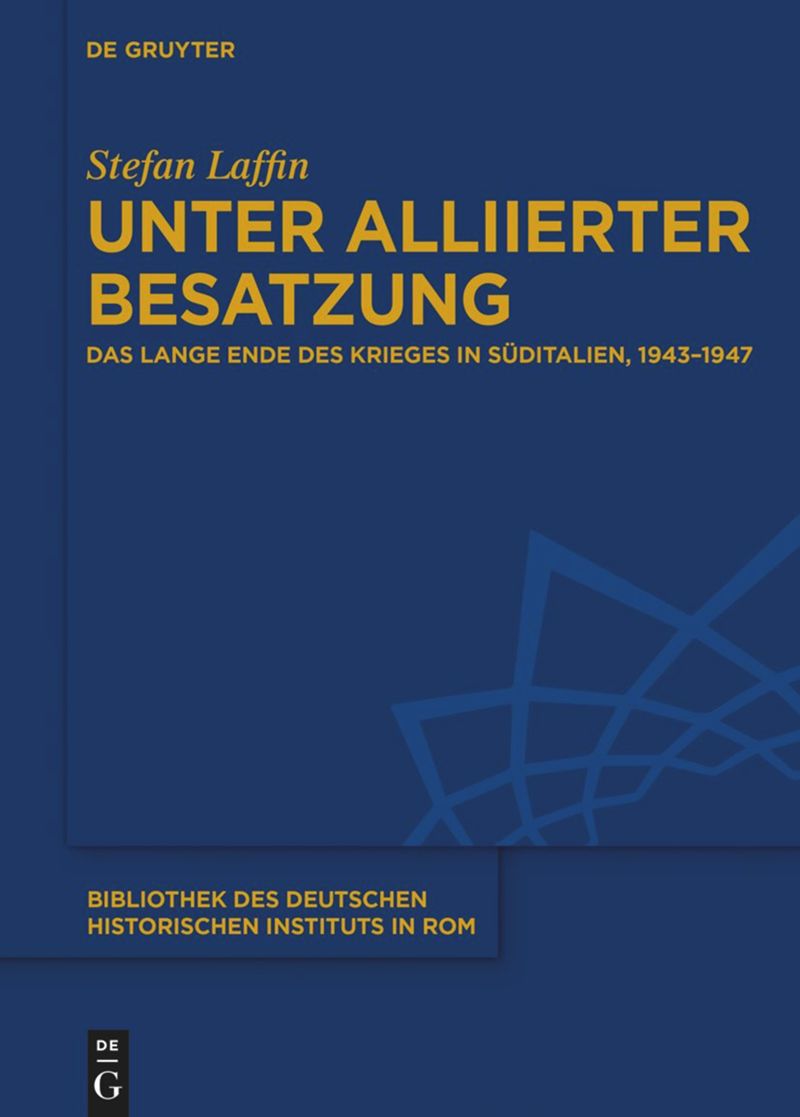


Reviewer Hendrik Geiling - Philipps-Universität Marburg
CitationWith his dissertation on the Allied occupation of southern Italy from 1943 to 1947, published in 2024, Stefan Laffin is very much in line with a recent trend in occupation history, which is increasingly focusing on the Allied occupations in Europe and Asia after the Second World War. This is evident not least in the programme of the Occupation Studies Research Network conference held in London in July this year[1]. With his work, Laffin fills fundamental gaps in research by presenting a comprehensive study of the history of the Allied occupation of southern Italy from 1943 to 1947.
Laffin’s book is a multi-perspective analysis of the interrelationships between local societies in southern Italy, Italian officials and the British and American occupiers, skilfully navigating the interface between structural occupation history and everyday and experiential history. The work is structured according to regional criteria (the three main chapters deal with the occupation history of Sicily, Calabria and Campania), which is very easy to follow. This structure enables the author to emphasise regional characteristics, draw comparisons throughout, and, above all, reveal the interconnections between regions that are very different in terms of their socio-structural characteristics. The main part is preceded by two chapters. Chapter two, which deals with the experiential and imaginary space of occupation, is particularly valuable for the study and lays important foundations for understanding the structure and functioning of the Allied occupation of southern Italy. In this introductory chapter, Laffin discusses the legal concept of occupation, examines the different perceptions and experiences of the British and Americans with regard to military occupation in general and the occupation of southern Italy in particular, and looks at the training of US officers who were prepared for their deployment as Civil Affairs Officers (CAOs). In this chapter, the author succeeds in empirically grasping specific preconditions and expectations, especially those of the CAOs, which are often neglected in works on the history of occupation. Chapter three deals with the Allied campaign in Italy and the emergence, structural organisation and functioning of the Allied Military Government of Occupied Territories and the Allied Control Commission.
In the regionally structured main section, Laffin highlights specific regional differences that characterised the regions of Sicily, Calabria and Campania during the occupation. For example, he discusses the attempts at cooperation and conflicts between the occupiers and the Sicilian independence movement, and how the Mafia, from its position of plural status as a local elite and criminal organisation, collaborated with the occupiers and was able to profit from the occupation. Rural Calabria was outside the Allies’ military priorities. No comprehensive and immediate military infrastructure was established here. Nevertheless, the occupation period had a strong impact on the region, for example through social struggles over resources that arose as a result of land movements. Using several examples from various sources, Laffin vividly illustrates how impoverished farmers and other dispossessed people attempted to seize land for themselves through illegal land occupations. The Allies rarely succeeded in resolving conflicts; on the contrary, they often exacerbated them, mainly through unilateral cooperation with old local elites. In comparison, the situation in Campania, which was significantly influenced by Naples, the urban centre of southern Italy, was different. Here, the Allies were busy trying to regulate the complex interconnected everyday life, such as the supply crisis and the thriving black market in the city. This chapter also focuses more strongly than previous chapters on the fact that the process of transferring powers back to Italian authorities was largely shaped by informal networks and decisions that enabled fascist officials and other old local elites to return to administrative positions. These processes were largely tolerated by the Allies.
However, a regional analysis of the Allied occupation also shows that southern Italy as a whole, albeit in different forms and to varying degrees, was characterised by a very difficult supply situation, a largely impoverished population and the associated social and political tensions, for which the occupying forces were unprepared. The Allies’ focus was on the ongoing war against the German Reich – no long-term occupation was planned. The Allies had to adapt to the complex and multifaceted problems they faced in occupied southern Italy in difficult negotiation processes in order to establish security and order – occupation never takes place in a vacuum. Laffin demonstrates this impressively. It is a pity that Laffin does not reflect further on the concepts of public security and order, given that he identifies the creation of security and order as a central goal of the Allied occupation. This would have benefited the study and historical scholarship in general, as there is a lack of theoretical classification of analytical categories and terms in the history of occupation. A reference to critical security studies, for example, or work that emerged in the context of the collaborative research centre “Bedrohte Ordnungen” (Threatened Orders) at the University of Tübingen could have enriched the book[2]. With regard to the experiential and everyday historical component of the occupied Italian population, the work must be considered limited in that hardly any personal documents, such as diaries or memoirs, written by Italians were included in the analysis. The author justifies this with a lack of quality of the material for his research questions, but does not elaborate on this justification. This creates an asymmetry in the experiential dimension of the work, as the author himself consistently notes. Especially from an experiential perspective, the book is primarily a history of the experiences of the CAOs. Overall, however, this does not detract from the outstanding quality and density of the study. A translation into Italian and English is highly desirable.
[1] “Events and Announcements”, Occupation Studies Research Network, https://fasos-research.nl/occupationstudies/events/ (accessed July 24, 2025).
[2] “Threatened Orders”, SFB 923 Bedrohte Ordnungen, https://threatened-orders.com/ (accessed July 28, 2025).